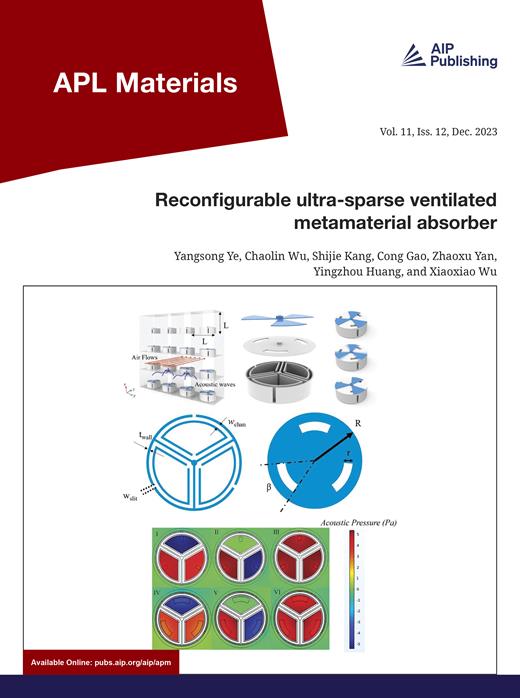Ni3S2 particle–embedded nanotubes as a high-performance electrocatalyst for overall water splitting
IF 5.3
2区 材料科学
Q2 MATERIALS SCIENCE, MULTIDISCIPLINARY
引用次数: 0
Abstract
Hydrogen evolution reactions (HERs) and oxygen evolution reactions (OERs) are crucial for renewable energy production. Developing stable, cost-effective, and highly catalytic HER and OER electrocatalysts is paramount. In this study, a combination of hydrothermal synthesis and annealing was used to fabricate nickel sulfide (Ni3S2) particle–embedded nanotubes supported on nickel (Ni) foam (Ni3S2 PN/NF). The Ni3S2 PN/NF structures featured a highly branched morphology with a large specific surface area, surpassing that of conventional Ni metal nanotubes. This design increased the number of reactive sites and enhanced the charge-transfer process. The Ni foam substrate expanded the contact area of Ni3S2, thereby improving conductivity and facilitating the adsorption/desorption of intermediates on the Ni3S2 surface. Density functional theory calculations showed that the electronic structure of Ni3S2 provides excellent conductivity. Moreover, the multi-branched structure and inherent conductivity of the NiS nanomaterials enhanced the Ni3S2 PN/NF performance in 1M KOH, with overpotentials of 87 and 210 mV with iR compensation at 10 mA cm−2 for the HER and OER, respectively. The synthesized Ni3S2 PN/NF also exhibited robust durability for 20 h. These results demonstrate that Ni3S2 PN/NF is an excellent catalyst for both HER and OER.作为整体水分离高性能电催化剂的嵌入式纳米管 Ni3S2 粒子
氢进化反应(HER)和氧进化反应(OER)对于可再生能源的生产至关重要。开发稳定、经济、高催化性的 HER 和 OER 电催化剂至关重要。本研究采用水热合成和退火相结合的方法,制备了硫化镍(Ni3S2)颗粒嵌入式纳米管(Ni3S2 PN/NF),并将其支撑在镍(Ni)泡沫上。Ni3S2 PN/NF 结构具有高度支化的形态,比表面积大,超过了传统的镍金属纳米管。这种设计增加了反应位点的数量,增强了电荷转移过程。泡沫镍基底扩大了 Ni3S2 的接触面积,从而提高了导电性,并促进了中间产物在 Ni3S2 表面的吸附/解吸。密度泛函理论计算表明,Ni3S2 的电子结构具有出色的导电性。此外,NiS 纳米材料的多分支结构和固有导电性增强了 Ni3S2 PN/NF 在 1M KOH 中的性能,在 10 mA cm-2 的 iR 补偿条件下,HER 和 OER 的过电位分别为 87 mV 和 210 mV。这些结果表明,Ni3S2 PN/NF 是一种出色的 HER 和 OER 催化剂。
本文章由计算机程序翻译,如有差异,请以英文原文为准。
求助全文
约1分钟内获得全文
求助全文
来源期刊

APL Materials
NANOSCIENCE & NANOTECHNOLOGYMATERIALS SCIE-MATERIALS SCIENCE, MULTIDISCIPLINARY
CiteScore
9.60
自引率
3.30%
发文量
199
审稿时长
2 months
期刊介绍:
APL Materials features original, experimental research on significant topical issues within the field of materials science. In order to highlight research at the forefront of materials science, emphasis is given to the quality and timeliness of the work. The journal considers theory or calculation when the work is particularly timely and relevant to applications.
In addition to regular articles, the journal also publishes Special Topics, which report on cutting-edge areas in materials science, such as Perovskite Solar Cells, 2D Materials, and Beyond Lithium Ion Batteries.
文献相关原料
公司名称
产品信息
阿拉丁
hydrogen peroxide
阿拉丁
thiourea
阿拉丁
polyethylene glycol [PEG, HO(CH2CH2O)nH, 99.0%]
阿拉丁
potassium hydroxide
阿拉丁
melamine
阿拉丁
Nickel(II) chloride hexahydrate
 求助内容:
求助内容: 应助结果提醒方式:
应助结果提醒方式:


